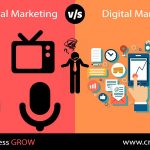The 3 Basic Components of Digital Marketing
Digital marketing has three leading components: Lead Generation, Lead Capturing and Lead Nurturing.
Stage 1: Lead Generation
The first step to digital marketing is planning and performing a lead generation strategy that pulls the correct people nearer to your brand. This is often all regarding selecting optimal messaging, targeting and techniques to talk to your audiences. From Search Engine Optimization (SEO) to Social Media Ads, there are many ways to accomplish this.
1.1- Search Engine Optimization (SEO) :
Search Engine Optimization (SEO) is the optimization of your website to rank higher on search engines (like Google). A decent search ranking permits your brand to induce additional exposure and generate additional organic traffic.
There are several factors that impact Search Engine Optimization (SEO), largely to try and do with the means your website is written and coded. Components like messaging, page speed, backlinks, UX and responsiveness all have an effect on your search ranking.
1.2- Search Engine Marketing (SEM) :
Search Engine Marketing (SEM) is the use of paid advertising to achieve additional visibility on search engines. If you’ve ever seen search engine results that say “ad” next to them, you’ve witnessed Search Engine Marketing (SEM).
Marketers bid on keywords that are most profitable for their business, permitting their website and content to indicate up higher on search engine results. By nature, Search Engine Marketing (SEM) results aren’t organic, however, results happen rather more quickly than they are doing with Search Engine Optimization (SEO).
1.3- Paid Social
Paid Social is the use of paid advertising to achieve your target audiences on social media. Platforms like Facebook, Twitter, LinkedIn, and Instagram provide robust ad choices, permitting you to achieve hyper-specific audiences with branded content and offers.
Stage 2: Lead Capture
Once you attract the correct audiences to your content, you’ve got to create certain your digital presence is optimized to drive conversions. After all, the traffic you created within the Lead Generation section suggests that nothing if those users don’t convert.
2.1- Website
The best website is your key to driving conversions. Impeccable messaging, perfect design, strategic UX, and robust code close to creating your website a marketing machine. Once users land on your website, they ought to understand specifically who you’re and what they have to try and do next. In this way, your website acts as a marketing funnel, ushering guests straight to conversion.
2.2- Landing Pages
Landing pages are an extension of your website; they’re complete pages typically leveraged in campaigns. Their worth lies in their ability to drive users to require specific actions, like claiming a suggestion or downloading an eBook. Landing pages facilitate users to specialize in the provide at hand, instead of obtaining lost within the pages of your website.
2.3- Forms
Forms are arguably the foremost necessary a part of any website or landing page. They’re specifically what they sound like – digital forms wherever users will fill out their personal info, like name, telephone number or email address. Users give this information in exchange for offers or additional data. This is often the way guests convert into leads.
Stage 3: Lead Nurturing
So, you’ve targeted the correct people and they’ve converted into leads. Now it’s your right time to shine. The lead nurturing section consists of providing your hard-earned leads with relevant, perceptive content to drive them nearer to your brand and persuade them to shop for.
3.1- Email Drip Campaigns
Email drip campaigns are sets of emails that automatically leave when users take specific actions or hit certain milestones. These campaigns send applicable content to potential clients at the correct time to drive engagement and purchases.
3.2- Personalization
Personalization is the application of user information to customize the digital expertise for every individual. It may be as easy as well as a lead’s name in an email or as advanced as serving up a unique website expertise supported a user’s interests.
While digital marketing may be an advanced method, we hope this article can assist you to raise the correct queries and gain a deeper understanding of the digital landscape. Armed with this data, you’ll be ready to drive your brand to digital success.



